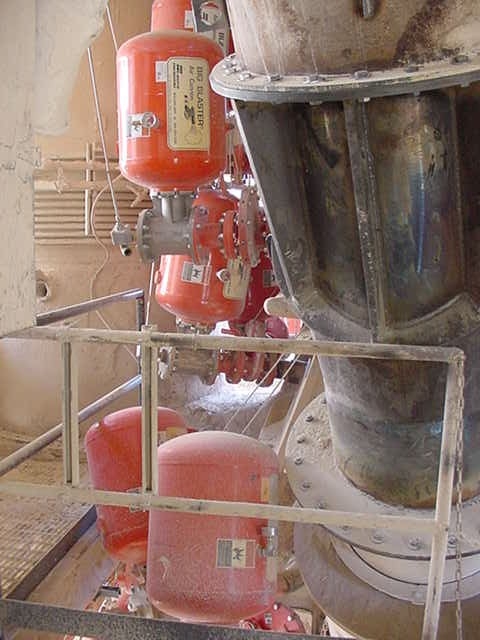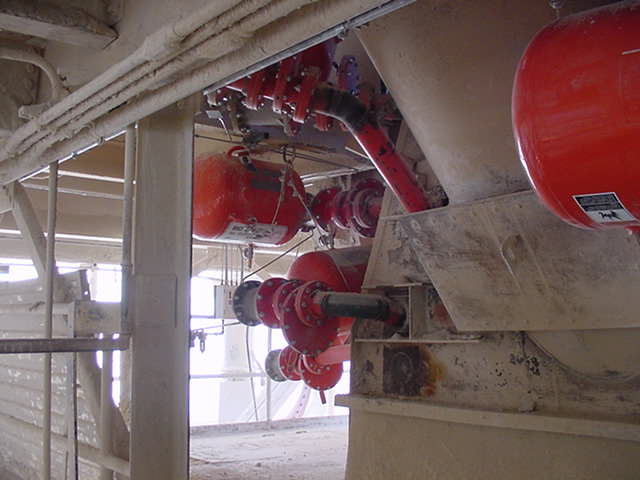Ash Grove Cement Resolves Buildup with Air Cannons
Published: September 4th 2014

Ash Grove Cement is the sixth-largest producer in the U.S., with nine manufacturing plants, two deep water import terminals and a major quarry operation in Blubber Bay, British Columbia. In all, the company has a total annual capacity of nearly 9 million short tons of cement, including a wide range of specialty products for difficult service environments. Located on the south bank of the Platte River between Omaha and Lincoln, the facility in Louisville, Nebraska has an annual output of about a million ST per year of Portland and blended cement.
When system operators began noticing material buildup in the precalciner, they found that it was impeding the flow through the preheater and into the kiln. The staff used the common technique of water lancing to remove blockages, particularly from the preheater tower’s riser duct. But the time-consuming process had to be repeated twice daily, when maintenance personnel would open access doors into the tower and remove the accumulation with a high-pressure spray.
“Efficient material flow is a critical element of dry-process cement manufacturing, and accumulation or blockages can take a big bite out of a plant’s profitability,” explained Martin Engineering’s Andy Marti. “Although many plants still use manual techniques to remove build-up, the cost of labor and periodic shutdowns has led many producers to investigate more effective methods for dealing with this type of maintenance,” he said.
Air-Powered Solution
In order to prevent the loss of efficiency and clinker quality at Ash Grove Louisville, a group led by process engineer Mark Junkins investigated possible solutions. They met with material handling experts from Martin Engineering, and together the group designed a network of Martin® Air Cannons for the main production line.
Martin Engineering technicians installed the air cannons during a scheduled maintenance outage, starting where the accumulation appeared most severe: below the riser orifice, where the duct is reduced in size to increase velocity. The unique cannon design requires no high-temperature discharge pipes or special mounting plates, and discharge nozzles are embedded directly in the refractory lining of the preheater tower.
All of the air cannons in the main production line network are equipped with the Martin® XHV Valve, designed specifically to deliver premium performance and long service life in preheater towers, clinker coolers and other high-temperature applications. The negative pressure-firing valve was developed to provide reliable operation and long service life in challenging applications.
The cannons discharge in a timed sequence that moves in an upward spiral around the tower firing about 20 seconds apart, with the entire cycle taking just over eight minutes to complete. Control room operators can alter the schedule to accommodate a range of kiln pressures and operating conditions, extending the sequence to as much as 45 minutes.
A crew from MartinPLUS® Services installed the entire system, including cannons, air lines and controls, as well as the company’s Thermo Safety Shield™ on each unit. Operating like trap doors, the sliding shields bolt in between the air cannon valve and mounting flange, helping to protect workers from exposure to severe heat, gases and high-temperature materials.
 Stage II
Stage II
Based on its success with the initial air cannon system, Ash Grove started planning a similar system for the plant’s second production line. For that operation, engineers designed a network of 15 additional Martin® Air Cannons, equipped with Martin® Tornado Exhaust Valves. Described as the latest advancement in air cannon valve design, the patent-pending Tornado fires in response to a positive air pressure surge delivered by a solenoid valve, which can be located as far as 200 feet away.
The unique design improves air cannon safety, since the discharge sequence requires a positive signal. Unlike negative pressure-firing designs, a cannon equipped with the Tornado valve will not discharge accidentally in response to a pressure drop, so an air supply failure or broken line won’t trigger its firing. In addition, this positive-acting valve amplifies the discharge force, delivering up to 20% greater force than a standard XHV-equipped air cannon of the same size.
Results
With the new air cannon network in place, the Louisville plant has been able to significantly reduce the need for water blasting. Material now flows more efficiently, and maintenance personnel have drastically reduced the man-hours that were spent on manual removal.
“We still hydro-lance occasionally, because of changes in raw material or fuel,” Junkins explained. “But we don’t have the issues we had before. We can see that the air cannon system has paid for itself, by allowing us to maintain production rates without many of the interruptions and issues that water blasting created.”